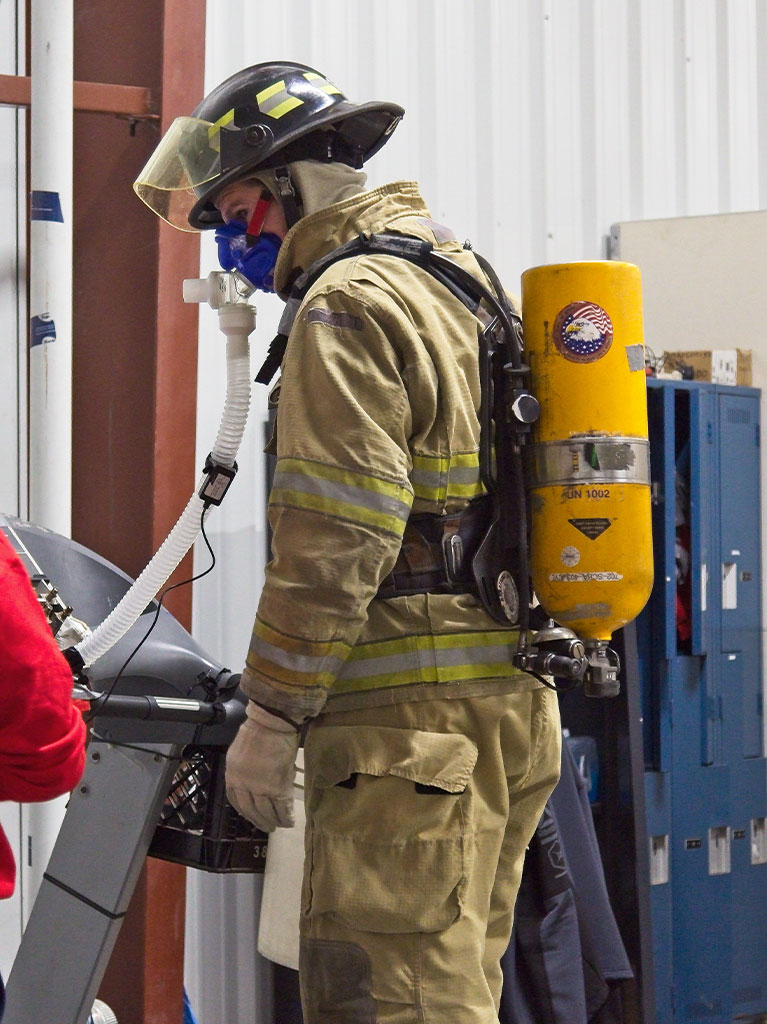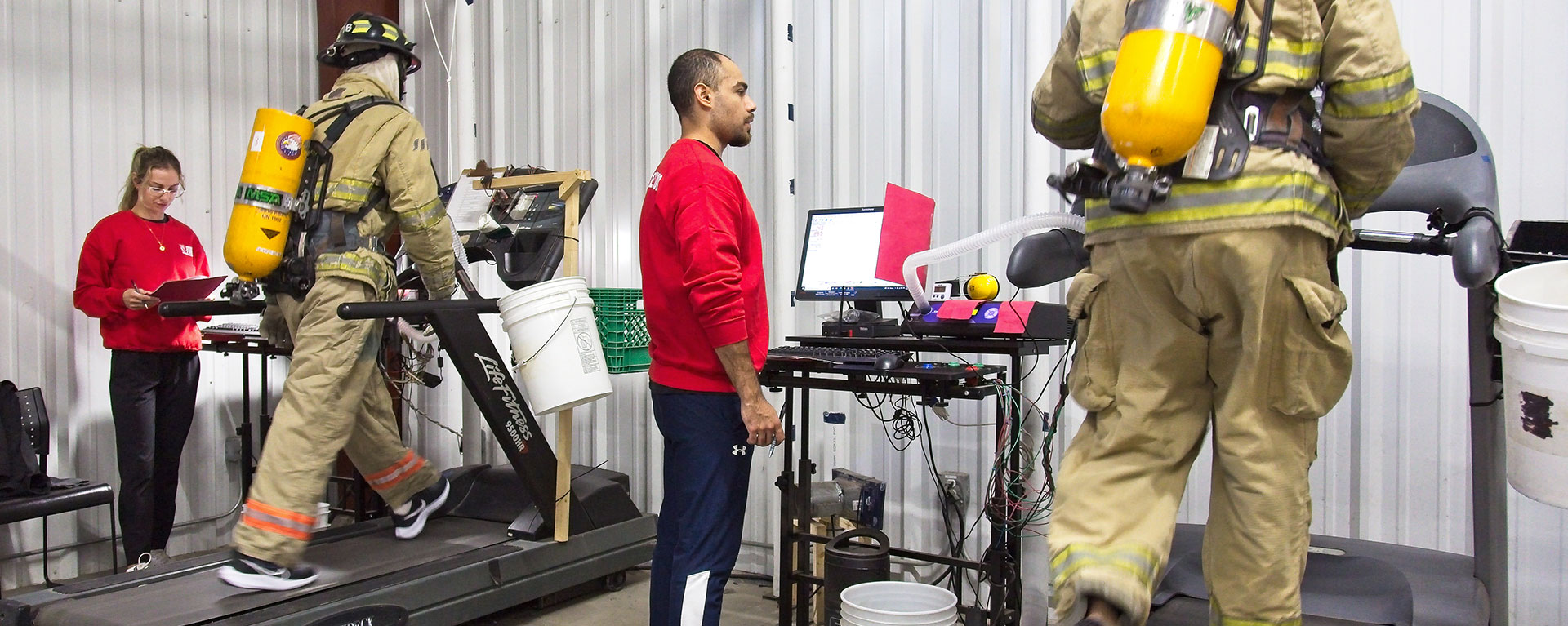Assessments
Stage Two – Encapsulated Treadmill Test
Applicants must demonstrate a level of physical fitness required of entry-level firefighters. Physical fitness is an integral component of firefighting. A commitment to a life-long fitness regime is essential to safely performing firefighter duties. To prepare for the intense physical demands of recruit training and for a career as a firefighter, applicants should already be following and maintaining a total body program specific to the job that focuses on flexibility, cardiopulmonary endurance, muscular strength and power, muscular endurance and healthy body composition.
The Encapsulated Treadmill Test is comprised of the following:
- Pre-Appraisal Screening
- Aerobic Fitness Evaluation-Encapsulated Treadmill Protocol
In order to take this assessment, you must pass your Stage One – Firefighter Aptitude and Character Test™ and Stage Two: Hearing Assessment.
Cost: $110.00 plus HST
Pre-Assessment Guide: Download
Important Notes Regarding the Encapsulated Treadmill Test: Please refrain from eating large meals or consuming large amount of liquids at least 2-3 hours prior to this assessment. DO NOT drink coffee (no caffeine), energy drinks or alcoholic beverages 12 hours prior to your evaluation. These can elevate your blood pressure and/or heart rate which could lead to the inability to pass your pre-screening leaving you unable to proceed with the assessment.
Please Note: Delays may occur at any stage of testing so we advise candidates to come prepared with food and water if they feel they will require it throughout the duration of testing. For the purposes of the Encapsulated Treadmill Test, it is advisable to only consume a small snack and water if required. Avoid all exercise 4 hours prior to this evaluation or intense exercise for 24 hours prior to testing. Ensure you use the restroom before participating in this assessment. Candidates are encouraged to be clean shaven for this assessment. Facial hair can cause the mask to have an improper seal leading to air leakage and possible failure of this assessment.

Candidates are given up to six readings for blood pressure and resting heart rate. If after the first reading, your pulse and/or blood pressure exceeds the required level you will be asked to rest in the cafeteria and come back at a specific time. If after six readings, your vitals are still outside of the expected range, you will not be able to continue with your assessment that day. Please contact the OFAI Administration office to re-schedule your assessment at 905-426-6756.
If you do not pass your pre-appraisal screening, this is not considered a fail, it is just not safe to proceed with physical testing on the specific test date.
Please Note: We do not accept doctor’s notes with respect to your blood pressure and/or heart rate. Your readings must be within the expected range during the pre-appraisal screening in order to proceed with the assessment. This is both for your personal safety and the safety of our Clinicians.
Candidates who are pregnant should obtain medical clearance before registering and participating in the Encapsulated Treadmill Test. Please contact the OFAI Administration office for more information.
Once each component of the pre-appraisal screening is successfully completed, the candidate is cleared to participate in the Encapsulated Treadmill Test.

Aerobic Fitness Evaluation-Encapsulated Treadmill Protocol
The encapsulated treadmill protocol is a progressive, incremental exercise test to exhaustion. This protocol is designed to evaluate the physical work capacities of healthy, physically active individuals. Each test requires a maximal effort. This assessment is completed while wearing firefighting personal protective equipment (PPE) that weighs approximately 23 kg (51 lb), depending on size. This ensemble includes: helmet, flash-hood, leather work gloves, coveralls, pants, jacket and self-contained breathing apparatus (SCBA). You will not breathe from the SCBA, but you must carry it. The VO2 mask is worn during this assessment and peak oxygen uptake (VO2peak) will be measured. However, your VO2 values do not determine whether you pass or fail. You are permitted to walk, jog and/or shuffle as required during this protocol.
Candidates are required to wear shorts and a t-shirt under the coveralls and PPE during this assessment. For safety reasons, running shoes must be worn in place of firefighting boots.
Please Note: It is the responsibility of the candidate to communicate with the evaluator regarding fit of all PPE. You must advise the evaluator of any concerns with your PPE or any other equipment related to your assessment prior to the commencement of your assessment. Candidates are NOT permitted to use their own PPE for this assessment with the exception of gloves. Candidates may bring their own gloves provided they meet the criteria as outlined here.
During Phase One, the treadmill is set to a speed of 3.5mph and there are gradual increases in grade over a five minute period. This is immediately followed by Phase Two, an eight minute period of constant work at 3.5mph and a 10% grade.
Once Phase Two is complete, you will immediately progress to Phase Three. During this phase the treadmill speed remains at 3.5mph but the grade increases 1% every minute to a maximum of 15%. Once a 15% grade is reached, the speed will increase by 0.5 mph each minute while the grade remains at 15% until you can no longer continue.
Once you have indicated you can no longer continue, you must complete Phase Four, which is 5 minutes on a flat treadmill at a slow speed. The protocol will continue until exhaustion or until other symptoms dictate that the test is terminated. You may stop the test at any time due to fatigue or discomfort.
In order to pass the treadmill test, you must complete the five minute Phase One, the eight minute Phase Two and the five minute Phase Four (for a total of at least 18 minutes). During the test, expired gases are monitored with an automated metabolic measurement system to calculate the rate of oxygen consumption. Heart rate is monitored continuously with a telemetry system.
At the end of the test you will be asked to rate your experience and overall exertion you felt during the test, based on the BORG Scale. This rating is used for clinical purposes only and has no bearing on the results of your assessment.
Borg Scale of Perceived Exertion
| 6 | No Exertion |
| 7 | |
| 8 | |
| 9 | |
| 10 | |
| 11 | Light |
| 12 | |
| 13 | Somewhat Hard |
| 14 | |
| 15 | Hard (Heavy) |
| 16 | |
| 17 | Very Hard |
| 18 | |
| 19 | |
| 20 | Maximal Exertion |


